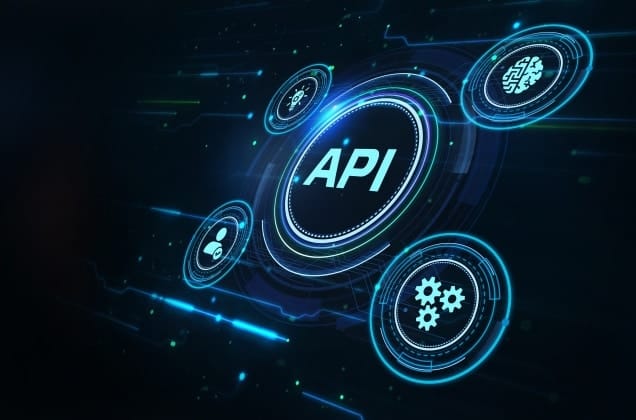What Are APIs and How Do They Work?

What are APIs exactly? In simple terms, an Application Programming Interface (API) is a software intermediary that allows applications to talk to each other. But it’s not just limited to applications; basically, it allows various types of digital systems such as, servers, cloud applications, and back ends of software to collaborate with each other and share meaningful information to process whatever requests end-users initiate.
Whenever users utilize an app, be it travel, ecommerce, entertainment, food delivery, or any other, it’s an API that brings to them the amazing user experience that enables them to search, order, and book all that they desire from the comfort of their homes. But of course, it’s more complex than that. Whenever an app software – be it social media or any other – is being used there may be several APIs at work behind the scenes that operate by a set of rules for communication.
In essence, the apps that we rely on for a ton of services rely on APIs to do a bunch of useful communication-related tasks to bring to us the ultimate user experience. Speaking of the user experience, it’s important to note that they bring the data or information needed to execute our requests and have nothing to do with the user interface that presents the information in an attractive or easy to understand manner. That said, it’s no less a feat.
Software AG Government Solutions deep-dives into what APIs are and their working to offer a sense of how they accomplish this.
What are APIs? And How Do APIs Work?
APIs work much like apps except that apps are built for human use whereas APIs cater to applications and other digital systems, serving as a messenger between them, carrying forth requests and responses to those requests. Let’s try to understand this with the help of a simple example.
Imagine that you’re at your favorite restaurant. When you’re ready to place an order, the waiter takes it down and passes it to the chef in the kitchen who starts to prepare it. And when your dish is ready the waiter carries it from the kitchen and serves it to you. In this case, the real transaction occurs between the kitchen and you – and the waiter is merely an intermediary that connects the two, carrying orders and food and drink from one to the other.
An API functions much like a waiter who is essentially a point of contact between the two. Just as the waiter connects the customer and the kitchen, an API connects an application (web or mobile) and the server. Or it may connect one or more applications, data servers, cloud apps, back-end software, and other digital systems.
The API is a reliable form of connection quite similar to the waiter who streamlines the task for both you and the kitchen. As a guest of the restaurant, you don’t need to make a trip to the kitchen or understand how it works to get your food order. And neither does the kitchen need to come to your table, it will simply prepare the food. And the waiter, who is familiar with your order, will instead bring your ready dish to you – easy, fast, and effective. So it is with the API.
API – the Backbone between Digital Systems
Whenever a user fires an application and requests an action or information, the app makes an API call to the server via the API. Every time a user uses an application it makes an API call to the API which then communicates the request to the server, which in turn responds with the required data. The app then delivers the raw data to the app, which then presents it to the user in an understandable format via the interactive GUI.
But how does an API communicate with the different digital systems? APIs have a set of rules with which they communicate with the different systems. They send the type of request, what info. is needed, and so on. There are several types of APIs, including REST APIs, SOAP APIs, GraphQL API, Browser APIs, Android APIs, and others.
APIs Make Code Reusable
What are the benefits of using an API? The key merit of APIs is that they allow code to be reusable. Instead of having to write code from scratch, developers can use APIs which serve as the founding blocks to build a program. But how do APIs make code reusable? An API is much like a universal plug as its functionality is free from the specific implementations. So these implementations can be tailored to fit the specific need of a program without impacting its basic functionality.
Moreover, the beauty of APIs is that they eliminate the need to write code for complex and repetitive processes, thanks to their reusability. Serving as a ready base upon which programs or applications are built, APIs have contributed immensely to the development process by tremendously cutting down the required time, effort, and resources. Developers can direct all their attention to building world-class apps instead of having to write code over and over again for repetitive tasks, both simple and complex.
API Integration
Often times the term “API integration” gets thrown around a lot so it’s worthwhile to know what it means. API integration means nothing but how two or more applications and systems are connected to each other with the help of APIs, which enable the sharing of information. As they form an important connection between systems, they help bridge the gap between several types of systems. As such, APIs enjoy widespread applications. They also help with data synchronization so that the data integrity is always maintained between several platforms.
Are You Looking for a Ready API Integration Platform?
We hope our guide to understanding what APIs are and how they function provided a good idea about their working and benefits. Software AG Government Solutions offers various APIs, Integration, and Microservices. APIs in government organizations can help automate repetitive tasks to significantly improve productivity, reduce turnaround time, and enhance accuracy. A special case in point is webMethods – one of our other offerings which is a great integration platform that helps connect two or more applications and also allows you to automate tasks. Learn more about our Government API Integration Software.
Want to keep up with all things Software AG Government Solutions?
Share your email address below.

View our upcoming events and on-demand webinars







